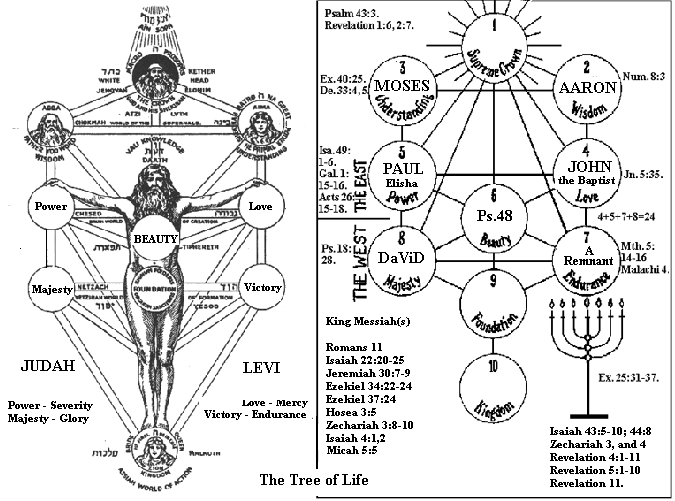
THE MYSTERY OF CHRIST
And without controversy great is the mystery of godliness: God was manifest in the flesh, justified in the Spirit, seen of angels, preached unto the Gentiles, believed on in the world, received up into glory...(1 Timothy 3:16).

And of his fulness have we all received...John 1:1-16, (Please see Chapter 1, part 2).
Of whom we have many things to say, and hard to be uttered...
For when for the time we ought to be teachers, we have need that one teach us again which be the First principles of the oracles of God; and are become such as have need of milk, and not strong meat. (Understand Isaiah 28:9; 1 Corinthians 3:1,2).
For every one that useth milk is unskilful in the word of righteousness: for he is a babe.
But strong meat belongeth to them that are of full age, even those who by reason of use have their senses exercised to discern both good and evil...(Hebrews 5:11-14).
__________
But in the days of the voice of the Seventh angel, when he shall begin to sound, the mystery of God should be finished, as he hath declared to his servants the prophets...(Revelation 10:7...KJV).
Invest your minds in the following images and divine concepts. Get the vision:
REVELATION, CHAPTER 5 (KJV).
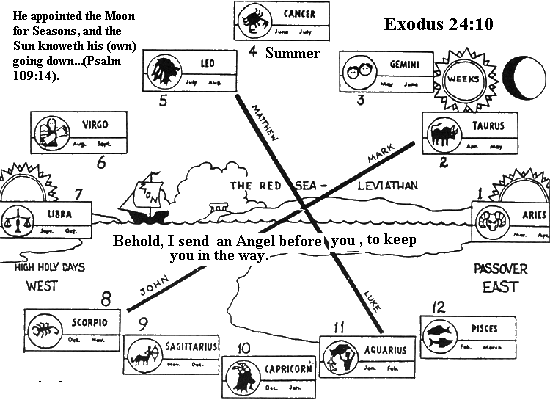
Open the Book of Ezekiel, here in America, in the fulness of time.
Understand the words: I will declare the decree: the Lord hath said unto me, THOU ART MY SON: THIS DAY HAVE I BEGOTTEN THEE...(Psalm 2:7; Exodus 4:22; Hebrews 3:13-15...KJV).
And they saw the God of Israel (the Angel of Divine Presence); and there was under His Feet as it were a paved work of saphire (sefirot) stone, and as it were THE BODY OF HEAVEN IN ITS CLEARNESS...(Exodus 24:10; 1 Corinthians 15:5-8).
(Read The Mystical Shape of the Godhead, by Gershom Scholem).
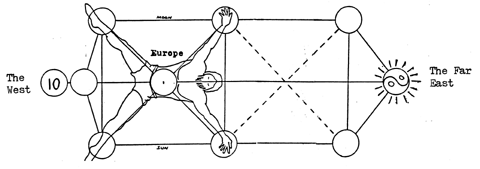
Jesus said, They who have recognized the world have found the Body (a Corpse), and they who have found the Body are superior to the world...(Gospel of Thomas 56 and 80).
Blessed be the God and Father of our Lord Jesus Christ (the Hesus of the Druids, and the Crishna of the Hindus), which according to his abundant mercy hath begotten us again unto a lively hope by the Resurrection of Jesus Christ from the dead (Revelation 1:17,18).
To an inheritance incorruptible, and undefiled, and that fadeth not away, reserved in heaven (in those dimensions beyond your comprehension) for you.
Who are kept by the Power of God through faith unto salvation, READY TO BE REVEALED IN THE LAST TIME...
Of which salvation the prophets have inquired and searched diligently, who prophesied of the grace that should come unto you:
Searching what, or what manner of time THE SPIRIT OF CHRIST WHICH WAS IN THEM did signify, when it testified beforehand the suffering of Christ, and the glory that should follow...(1 Peter 1:3-5, 10,11).
__________
Howbeit we speak wisdom among them that are perfect: yet not the wisdom of this world, nor of the princes of this world, that come to nought:
But we speak the wisdom of God in a mystery, even the hidden wisdom, which God ordained before the world unto our glory.
Which none of the princes of this world knew: for had they known it, they would not have crucified the Lord of glory...(1 Corinthians 2:6-8).
__________
For as the Body is one, and hath many members, and all the members of that one Body, being many, are One Body, so also is Christ...
For the Body is not one member, but many...(1 Corinthians 12:12, 14).
___________
Till we come in the unity of the faith, AND OF THE KNOWLEDGE OF THE SON OF GOD, UNTO A PERFECT MAN, unto the measure of the stature of the Fulness of Christ...(Ephesians 4:13; Genesis 5:1,2).
THE COUNCIL OF NICEA DID NOT ATTAIN TO THIS KNOWLEDGE
(1 Corinthians 3).
The dispute: Jesus was God, but not man. Jesus was man, but not God. Jesus was both God and man. The reality: Jesus never existed as one single individual alone, but is, instead, the perfect revelation of the Logos, the Word (the Wisdom of this Universe), God's manifestation of Themselves in all things, throughout all times, and in every living being. It is Christ-conscious individuals--such as John the Baptist, Paul, and all the adepts of the early Church in their time, as well as those who are coming to spiritual perfection in our own time--who come to the realization of these things. (Revelation 2:17...KJV). It is understood in the Vedic precept: Brahmin is Atman: Christ in us, and God in Christ.
To make all men see what is the Fellowship of the Mystery, which from the beginning of the world hath been hid in God, who created all things by Jesus Christ...(Ephesians 3:9; 1 Corinthians 2:12,13, KJV).
He appeared to them all. He appeared to the great as great, and to the small as small...to the angels as an angel, and to men as a man...Some indeed saw him thinking they were seeing themselves, but when he appeared to his disciples on the mount (Matthew 17:1-7) he was not small. He became great and made his disciples great that they might be able to see him...(Gospel of Philip).
It is not possible for anyone to see anything that actually exists unless one become like them. This is not the way with (the unspiritual) man in the world. He sees the sun without being a Sun, and he sees heaven and earth and all these things, but he is not these things...But you saw the Spirit and became Spirit, you saw Christ and became Christ. So in this place (the natural state of mind) you do see yourself. But in that place (the spiritual state of mind) you do see yourself, and what you see you shall become...(Gospel of Philip).
But we all, with open face beholding as in a glass the glory of the Lord, are changed into the same image from glory to glory, even as by the Spirit of the Lord...(2 Corinthians 3:18).
Whereby when ye read ye may understand my knowledge in the Mystery of Christ, which in other ages was not made known to the sons of men, as it is now revealed unto His holy apostles and prophets by the Spirit...(Ephesians 3:4,5).
To comprehend the mysteries of Christianity it is first of all essential to distinguish between John's baptism and Paul's. John saw the Metatron, the terrible Angel of Divine Presence, while Paul looked into the same oracles and saw Christ Crucified (Acts 18:24 to 19:5...KJV). And then to realize how these two visions compliment each other, how they are essential to each other and how they were personified in the literary and corporate efforts of the early Church. These adepts could see the Angel of Divine Presence (YHVH--the Invisible Glory of God) risen up everywhere in all the powers of the earth...(Understand Bhagavad Gita. Understand the realities of the 20th, and now the 21st centuries). They realized the Angel's literary as well as historic relationship to the figure of YHShWH (Jehoshua), the captain of the hosts of Israel (Joshua 5:13-15), and to the epic role that the higher Israel would play among the nations of the earth in the last days. This was John's baptism. (Please see Chapter 6):
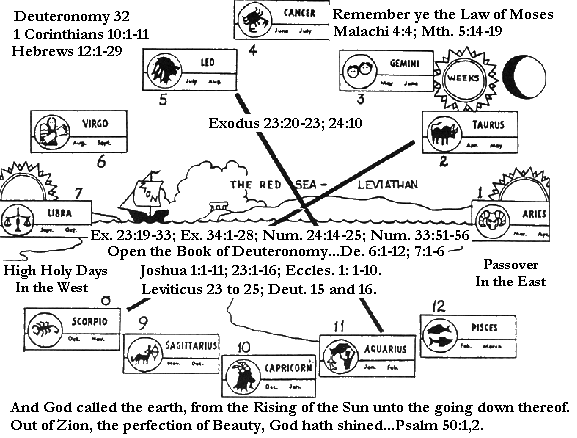
(Exodus 15; Ex.19; Deuteronomy 4; De. 32:16-42; 1 Samuel 2:1-10; 2 Samuel 22; Psalm 18:6-15; Isaiah 30:25,26; Zephanaiah 1:14-18; Isaiah 63:1-4; Isa.66:1-18...KJV).
"For they (the Essenes) take up the sacred Scriptures and philosophies concerning them, investigating the allegories of their national philosophy, since they look upon their literal expressions as symbols of some secret meaning of nature, intended to be conveyed in those figurative expressions.
Now the interpretation of the sacred Scripture is based on the under-meaning in the allegorical narratives: For these look upon the whole of their law-code as a Living Being, having for a Body the spoken commands, and for a soul the unseen thoughts stored up in the words…. The interpretation as it were, in the mirror of the names, catching sight of the extraordinary beauty of the ideas contained in them, unwrapping and unrobing the symbols from them, and bringing to light the naked inner meanings for those who are able with a little suggestion to arrive at the intuition of the hidden sense from the apparent meaning." Philo, On the Contemplative Life.
__________
"Mention of the Essene hopes of a New Age of glory leads us naturally to some comments on the special theological views of the Essenes that informed their understanding of history and gave to their community its peculiar institutions. The Essenes belong in the center of that movement (known as) apocalypticism. THE LATER VISIONARIES of the Old Testament, notably the author of Daniel, as well as the later Baptist and Christian communities, DISCOVERED THEMSELVES TO BE LIVING IN THE LAST DAYS OF THE OLD AGE, or rather IN THE DAYS WHEN THE OLD AGE WAS PASSING AWAY AND THE KINGDOM OF GOD WAS DAWNING. According to apocalypticism, THE UPSURGE OF EVIL POWERS IN THE WORLD REFLECTED THE LAST DEFIANT OUTBREAK OF COSMIC SATANIC POWERS. The gifts of the Holy Spirit manifest in the community of the faithful, adumbrated the age of the Spirit TO FOLLOW THE FINAL WAR IN WHICH THE SPIRIT OF TRUTH AND HIS HEAVENLY ARMIES WOULD PUT AN END TO THE RULE OF THE POWERS OF DARKNESS. The constitution of the Essene community was a crystallized apocalyptic vision. Each institution and practise of the community was a preparation for or, by anticipation, a realization of, life in the New Age of God's rule. ON THE ONE HAND, THEIR COMMUNAL LIFE WAS A REENACTMENT OF THE EVENTS OF THE END TIMES, both the final days of the Old Age AND the era of Armegeddon. (An understanding that is reflected everywhere in the Gospel narratives). On the other hand, their community, being heirs of the kingdom, participated already in the gifts and glories that were the first fruits of the Age to come. FOR THE APOCALYPTICISTS OF QUMRAN THE KEY TO THESE FUTURE MYSTERIES WAS AT HAND. ONE HAD ONLY TO READ BIBLICAL PROPHECIES WITH THE UNDERSTANDING GIVEN THE INSPIRED INTERPRETER (that is, one who reads with the power of the Holy Spirit) BECAUSE THE SECRETS OF EVENTS TO COME IN THE LAST DAYS WERE FORETOLD BY GOD THROUGH THE MOUTH OF THE HOLY PROPHETS…
In apocalyptic exegesis, three principles should be kept in mind. Prophecy openly or cryptically refers to the last days. Second, the so-called last days are in fact (in types and figures) the present, the days of the sect's life. And finally, the history of ancient Israel's redemption, her offices and institutions, are prototypes of the events and figures of the New Israel.
On this basis, the Essene camp in the wilderness found its prototype in the Mosaic camp of Numbers (Numbers 2 to 4; 9:15-10:28). The Essenes retired to Qumran to 'prepare the way of the Lord' in the wilderness. As God established His ancient covenant in the desert, so the Essenes entered into a New Covenant on their return to the desert. As Israel in the desert was mustered into army ranks in preparation for the Holy War of Conquest, so the Essenes marshaled their community in battle array and wrote liturgies of the Holy Warfare of Armageddon." Understanding the Dead Sea Scriptures by Hershel Shanks, pp.26,27.
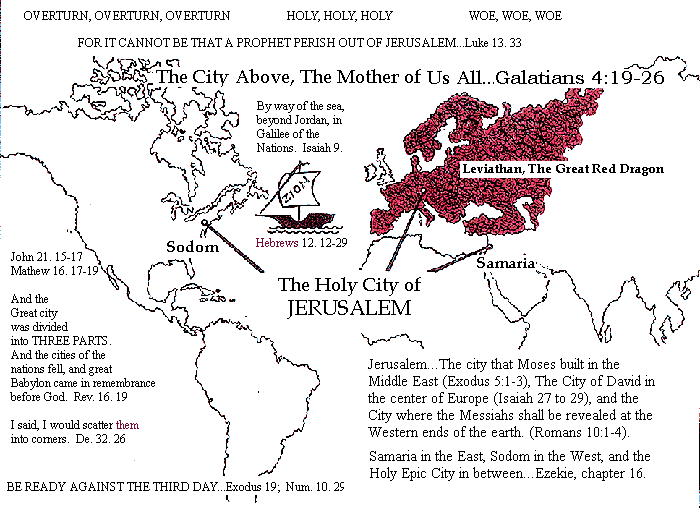
Open the Book of Acts, not in Palestine but in the Center of Europe (Acts 1:11 to 2:16-21/Joel 2:27-32, for these things were not done in a corner...Acts 26:26 (KJV).
And then, after returning to the Jerusalem above, and after their encounter with Paul (Elisha ben Abuyah), the Essenes were able to fully comprehend and integrate the idea of the Cross and the ancient connection that existed between the Druid Hesus (the suffering Christ suspended on the limbs of the Cosmic Tree) and the Hebrew mysteries. This was Paul's baptism. (Please see Chapter 7). .
And some said, What will this babbler say? others, He seemeth to be a setter forth of strange gods: because he preached unto them Jesus (the Druid Hesus), and the resurrection...(Acts 17:18).
But we see(JESUS) who was made a little lower than the angels for the suffering of death, crowned with glory and honour, that he by the grace of God should taste death for every man
For it became him, for whom are all things, and by whom are all things, in bringing many children unto glory, to make the captain of their salvation perfect through suffering.
For both He that sanctifieth, and they who are sanctified are all of one: for which cause He is not ashamed to call them brethren...(Hebrews 2:9-11).
That the God of our Lord Jesus Christ (Hesus-Crishna), the Father of glory, may give unto you the spirit of wisdom and revelation in the knowledge of him:
The eyes of your understanding being enlightened, that ye may know what is the hope of his calling, and what is the riches of the glory of his inheritance in the saints,
And what is the exceeding greatness of his Power to us-ward who believe, according to the workings of his mighty Power,
Which He wrought in Christ, when He raised him from the dead, AND SET HIM AT HIS OWN RIGHT HAND in the heavenly places,
Far above all principality, and power, and might, and dominion, and every name that is named, not only in this world, but also in that which is to come:
And hath put all things under his Feet, and gave him to be the Head over all things to the church.
WHICH IS HIS BODY, THE FULNESS OF HIM THAT FILLETH ALL IN ALL...(Ephesians 1:17-23).
The preceding verses, completely Kabbalistic in scope, are the result of Paul's vision of Christ. He did not learn it from the others, but rather taught it to them, forty years or more before the first written gospels began to be carried throughout the early Christian communities. Actually everyone was instructing everyone during that period. It took all that time for the adepts to sort out their theological point of view (to take into account both John's teachings as well as Paul's), and (conforming to the oracles), to incorporate the whole of it into a single Mystical Body of writings. Between them they purposfully and skilfully revealed what they would, and concealed the rest--all in the same Body of writings which we in our time call the New Testament. These writings prepare a pathway for the Son of man to follow, and establish the pattern of the Evening Sacrifice to be offered in the last days. (Exodus 29:37-39; Numbers 28:1-4; Revelation 11:13). Thus they anticipate an understanding of these things in our time (as the Books are opened). To understand it ourselves we must relearn the early Christian doctrine of metempsychosis (the passage of certain souls through time and space from one place in history to another--in other words, reincarnation), and then rediscover Paul and his relationship to the structure of the Sacred Oracle and the Mystery of Christ. We must understand it in order to see exactly who it is that has been set at the Right Hand of this sublime mystery:
THE CHRIST PRINCIPLE...Christ, or the Higher Self, is the fundamental principle underlying the idea of personnel Godhood; and is the Divine Life which proceeds forth from the Absolute, as the Son from the Father, to enter the world of manifestation and animate all things. He it is who is the Divine Sacrifice, in that he limits himself within all his creatures...
Now through that Divine effort of manifestation, all that is expressed and comprised in mineral, vegetal, animal and human, is lived through in due order in this underworld, whilst the essential Christ, the Lord in heaven, is "seated at the Right Hand of the Father;" that is, he lives as the Power Actual proceeding from Power Potential. He comes forth in the world-cycle as Savior and Judge in innumerable forms as the One Life operating diversely in many sheaths.
But God who is rich in Mercy, for His great love wherewith He loved us,
Even when we were dead in sins, hath quickened us together with Christ, (by grace are we saved);
AND HATH RAISED US UP TOGETHER, AND MADE US SIT TOGETHER IN HEAVENLY PLACES IN CHRIST JESUS...(Ephesians 2:4-6).
For in Him we live, and move, and have our being; as certain also of your own poets have said, For we are also his offspring...
Because He hath appointed a day, in which He will judge the world in righteousness by that man whom he hath ordained; whereof He hath given assurance unto all men, in that he hath raised him from the dead.
And when they heard of the resurrection of the dead, some mocked: and others said, We will hear thee again of this matter...(Acts 17:28-32).
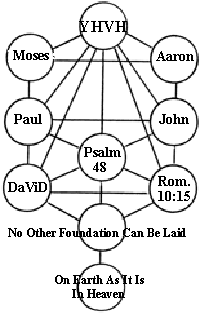
2 Corinthians 12:1 to 13:5; 2 Peter 3:14-18, (KJV).
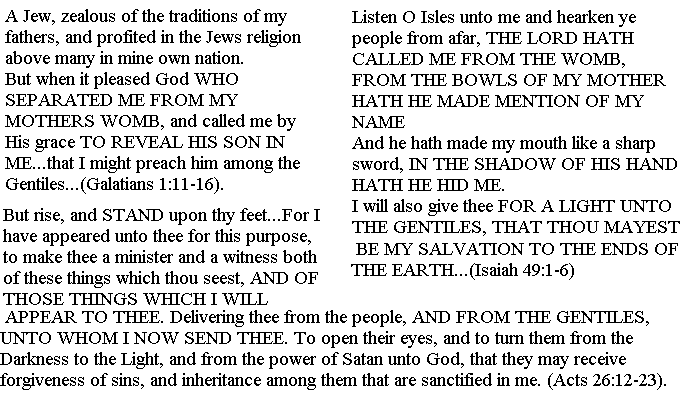
It was Paul himself who was set at the Right Hand of this great historical mystery of the Tree of Life. (Please consider Chapter 8). It was Paul, the founder of Christianity, that looked into the hidden space-time continuum (nineteen hundred years before Einstein) and saw the Lord of Glory present in all things, in every human event, in every birth and in every death, and therefore in every living being, thus the words:
That Christ may dwell in your hearts by faith; that ye, BEING ROOTED AND GROUNDED IN LOVE,
May be able to comprehend with all saints what is the Breadth, and Length, and Depth, AND HEIGHT;
And to know the love of Christ, which passeth knowledge, that ye might be filled with all the fulness of God...(Ephesians 3:17-19).
Giving thanks unto the Father, which hath made us meet to be partakers of the inheritance of the saints in light:
Who hath delivered us from the power of darkness, and hath translated us into the kingdom of His dear Son:
In whom we have redemption through his blood (the Blood of the Covenant), even the forgiveness of sins:
Who is the image of the invisible God, the firstborn of every creature:
For by him were all things created, that are in heaven, and that are in earth, visible and invisible, whether they be thrones, or dominions, or principalities, or powers: all things were created by him, and for him:
And he is before all things, and by him all things consist.
And he is the Head of the Body, the church: who is the beginning, the firstborn from the dead; that in all things he might have preeminence.
For it pleased the Father that in him should all fulness dwell;
And, having made peace through the blood of his Cross, by him to reconcile all things unto himself: by him, I say, whether they be things in earth, or things in heaven...(Colossians 1:12-20).
THE GOSPELS
FIRST PERIOD...A.D. 30 to A.D. 80. The APOSTOLIC AGE...This is an attempt to write a history of the Christian religion during the first two centuries. Not a history of Christianity, which would require us to follow the principles of that religion, in their dissemination through various countries, and in their influence upon other institutions. Nor yet a history of the church ; which would make it necessary to examine the questions of ecclesiastical polity, to trace the rise and progress of different forms of church government, and to notice the manners and customs of the early Christians, and their treatment by the civil magistrates
These are touched upon only in their bearing upon the main object of the inquiry; which is, an examination into the principal doctrines distinctive of the Christian religion, so far as they were known and taught in the first two centuries; also the principle traditions and books by which those doctrines were disseminated... The difficulty of the undertaking is great. THE GOSPELS OF THE FIRST CENTURY ARE UNFORTUNATELY LOST...
When Christianity had become partially established BY THE TEACHING OF CHRIST and the preaching of his apostles and disciples, there arose among the Christians of the various churches a necessity, and hence a demand, for some written testimonies or records of the life and doctrines of the great master. But this need was not so apparent or pressing in the first century, and especially during the lifetime of those who had been with Jesus, and had been his followers and companions.
Of the numerous gospels which were in circulation in the second century, not more than three can with any certainty, or with any high degree of probability, be traced back to the times of the apostles. These are THE GOSPEL OF PAUL, THE GOSPEL or RECOLLECTIONS OF PETER, and the ORACLES or SAYINGS OF CHRIST, attributed to Matthew.
THE GOSPEL OF PAUL...Ewald, one of the best of the German critics, concludes that there was a Gospel of Paul; thinks it was in the Greek language, and that it may have been written by the evangelist Philip. It may be inferred that it afterward became incorporated into the Gospel of Marcion (A.D. 145), since Marcion was a follower of Paul, and for his own gospel claimed the sanction of that apostle.
Marcion was a native of Sinope, a town of Asia Minor, on the south shore of the Black Sea. It is supposed that the church at Sinope was furnished by Paul, at the time of its formation, with a collection such as he supplied to the other Asiatic churches; containing the life and teachings of Christ.
It was the opinion of Jerome, and of several other writers, THAT WHEN PAUL SPOKE OF HIS GOSPEL (Romans 2:16; 16:25; 2 Thess.2:14), he referred to a written gospel then in circulation. Paul may have had such a gospel in mind; but his language is not sufficiently explicit to justify us in concluding, with any certainty, that he meant any thing more than that gospel of which he was the great expounder.
There is, however, a more distinct trace of the Gospel of Paul in his First Epistle to the Corinthians (11:23-25). By comparing this passage with Luke 22:19,20, it will be seen that the language is almost identical; while the parallel passages, Matthew 26:26-28, and Mark 14:22-24, have no such complete similarity, though the idea is the same. The Gospel of Luke, whether directly, or through Marcion's, was found partly upon the Gospel of Paul. That Paul had something to do with a written gospel, which now appears in whole, or in part, in the compilation of Luke, is generally acknowledged; and this passage in First Corinthians, taken in connection with the corresponding passage in Luke, is strong evidence that in Corinthains Paul refers to a written gospel, which he had delivered to the church at Corinth...Paul may have referred, also, to the same gospel in Galatians 2:2...
(From the writings of Tertullian...Tertullian adv. Marcion, bk.4, ch.2, Ante-Nicean Christian Library) it is manifest, first, that there was a Gospel of Paul, and the inference was very strong that it was in writing; since Paul is represented as going to Jerusalem to compare his gospel with another, and while there, conferring with the authors of the other gospel; secondly, that it was necessary, for the purpose of verification, that these two gospels should be compared; thirdly, that all this was anterior to the Gospel according to Luke...
The opinion of Ewald is, that the Greek Gospel of Paul was the first ever written. There was probably no great length of time intervening between the origins of that and of the other two gospels of the first century.
The testimony of Iranaeus (A.D. 190) concerning this gospel is, that it was written by Luke: "Luke also, the companion of Paul, recorded in a book the gospel preached by him."
Notwithstanding the positive language here used, the statement is to be taken with some allowance. Iranaeus was fully committed to the Four gospels, and was engaged in endeavoring to give them authority. He may be said, in fact, to have introduced them to the literary world; since he is the first author who mentions more than one of them. He speaks frequently of these gospels, and argues that they should be Four in number, neither more nor less, because there are Four universal winds, and Four quarters of the world...History of the Christian Religion to the Year Two Hundred, by Charles B. Waite, A.M., pp.1-6.
THE ORIGIN AND SOURCES OF THE FOUR GOSPELS
While we do not know where or by whom the Four New Testament gospels were written, scholars realize that they are compilations assembled by what we would call today editors, who drew on various traditions, both oral and written, of the early Christian communities. Because of this, the written gospels originate from complex layers of earlier materials from a wide variety of sources. These include collections of "sayings of the Lord" (like the sayings Gospel of Thomas), collections of miracle stories used by early Christian missionaries, dialogues attributed to Jesus, a passion narrative, miscellaneous legends, and other special sources specific to individual gospels, to name the most obvious.
From a historical standpoint, this diversity of sources makes it difficult to paint an accurate portrait of the historical Jesus. While there are undoubtedly some historically reliable teachings and accounts of Jesus in the New Testament, it's impossible to know which ones are and which ones aren't. This fact was recognized long ago by the early church father Origen, who pointed out that some incidents related in the gospels never took place in a "material" or "corporeal" sense, but are spiritual allegories meant to be studied as such; as he states clearly, "the careful student may observe countless other instances in the Gospels, and may thus be convinced that with the historical events, literally true, different ones are interwoven which never occurred."...Jesus Christ Sun of God, by David Fideler, pp.104, 105.
THE GOSPEL OF THE KINGDOM
"And this gospel shall be preached in the whole world for a testimony unto all nations; and then shall the end come." (Mat.24:14). The "gospel of the kingdom" is the spiritual "book of life" which set forth the course of the evolution of the soul; it contains the history of "just men made perfect" in all their qualities...The end must arrive for all that is less than perfection...
"Basilides added, that the life of Christ was the beginning of a progressive shaping and forming of the individual souls of believers, as thoughts of God, out of the shapeless form of unconscious material or psychical existence...The history of mankind is the type of the evolution of creation." Bunsen, Hippolytus, etc., Vol. I. p.120.
The message of Wisdom (Holy Ghost) may be suggested from outside, but it's power and the conviction of its truth can only be found within. "And this too we must bear in mind, that as the law contains a shadow of good things to come...so the Gospel also teaches a shadow of the mysteries of Christ...What John calls the eternal Gospel, and which may properly be called the spiritual Gospel, presents clearly to those who have the will to understand, all matters concerning the very Son of God, both the mysteries presented by his discourses and those matters of which His acts were the enigmas." Origen, Comment of John, Bk.I. p.9.
"By the Gospel and the preaching of the Gospel is signified the annunciation of the coming of the Lord and of His kingdom" Swedenborg, Apoc. Rev. n. 626.
"The gospel is that of the revelation of God in Christ, who is the Alpha and Omega, the beginning and the end, the first and the last. The gospel of Christ would be powerless to help in readjusting life's beginnings and endings unless he were himself in very deed a revelation of the cosmic secret, the heart divine that beats at the center of all existence and seeks its own by way of the cross..." R. J. Campbell, Sermon, Beginnings and Endings.
CRUCIFIXION OF JESUS, ACCORDING TO THE GOSPELS
"The canonical gospels exist as a sequence of narrative and dramatic scenes. This is not surprising; how else would one tell the story of Jesus? What is surprising is the great differences among the stories...For example, according to Matthew and Mark, the dying words of Jesus were, 'My God, my God, why hast thou forsaken me?' According to Luke, Jesus dying words were, "Father, into your hands I commit my spirit.' But according to John, they were, 'It is accomplished.' To put it another way, we cannot know what the dying words of Jesus were, or even whether he uttered any; it is not that we have too little information, but that we have too much. Each narrative implicitly argues that the others are fictional...
The matter becomes even more complex when we add to it the virtual certainty that Luke knew perfectly what Mark had written...and the liklihood that John also knew what Mark and perhaps Luke wrote, but both Luke and John chose to tell the story differently. AS IT HAPPENS, ALL THE DEATH SCENES WERE CONSTRUCTED TO SHOW JESUS DYING THE MODEL DEATH (The death of the Cross) AND DOING SO IN FULFILLMENT OF THE SCRIPTURES...
Numbers 21:5-9; Deuteronomy 21:22,23; Psalm 22; 69:21; Isaiah 53; Zechariah 12:10
...What this means I shall discuss later, but for now suffice it that the scenes have a religious and moral purpose disguised as a historical one; we are, with these scenes, in a literal realm known as fiction, in which narratives exist less to describe the past than to affect the present. In De Quincey's phrase, the Gospels are not so much literature of knowledge as literature of power." Gospel Fictions, The Art of the Gospels, Theology as Fictional Narrative, by Randel Helms.
(A SYMBOL OF THE FINAL ANGUISH OF THE INCARNATE SOUL AS IT REACHES PERFECTION, AND THE LOWER NATURE IS OVERCOME)
"And about the ninth hour Jesus cried with a loud voice, saying, My God, my God, why hast thou forsaken me? (Mat.27:46). The "ninth hour" refers to the period of attainment of perfection on the three lower planes. The crucifixion not yet being completed, the cry of mental distress and despondency signifies that the soul is temporarily agonized by this transition state, for it is not yet entirely alive to the nature of the highest conditions of Being...When the identification is complete, the consciousness has risen to the causal-body, and the suffering lower nature has been exchanged for bliss." W.R. Inge Paddock Lectures, p.57.
The heavenly Christ, or Higher Self, is to be understood as always associated with the struggling Lower Self symbolized by Jesus. The cry of the lower to the Higher indicates the lower consciousness on the verge of union with the Higher, but still perceiving its separateness from it. The expression "My power my power, why hast thou forsaken me?" (Apoc. Gospel of Peter) must be regarded as meaning "my Divine Life and strength," which for a moment the personality realized as departing from it--the mortal personality. It must be remembered that it is the "earthly person" or lower personality signified by the "body of Jesus," which dies when the Divine spark has been withdrawn from it.
"And Jesus cried again with a loud voice, and yielded up his spirit." (Math.27:50). This signifies the consummation--the ultimate suffering, and then the triumph over the ultimate ills of the lower planes--the Soul's liberation and final withdrawal from the lower manifestation...
I am crucified with Christ: nevertheless I live; yet not I, but Christ liveth in me: and the life which I now live in the flesh I live by the faith of the Son of God who loved me, and gave himself for me. (Who is Paul referring to here? Think of John, James, and all the others who offered the Morning Sacrifice)...(Galatians 2:20).
But God forbid that I should glory, save in the Cross of our Lord Jesus Christ, by whom the world is crucified unto me, and I unto the world...(Galatians 6:14).
Although Redemption as a whole is one, the process is manifold and consists of a series of acts, spiritual and mental. Of this series, the part wherein the individual finally surrenders his own exterior will, with all of its exclusively material desires and affections, is designated the Passion. And the particular act whereby this surrender is consummated and demonstrated, is called the Crucifixion. This crucifixion means a complete, unreserving surrender--to the death, if need be--without opposition, even in desire, on the part of the natural man. Without these steps there is no atonement. The man cannot become one with the Spirit within him, until by his Passion and Crucifixion, he has utterly vanquished the "old Adam" of his former self.
Through the atonement made by means of this self-sacrifice he becomes as one without sin, being no more liable to sin; and is qualified to enter, as his and her own high priest, into the Holy of holies of his own innermost...The Perfect Way, p.215.
I am now ready to be offered...(Paul).
THE ART OF THE GOSPELS, THEOLOGY AS FICTIONAL NARRATIVE
...Without needing to insist that all the mythical (accounts of Jesus) entirely disregard his genuine acts...I shall use the word fiction rather than myth to refer to the study contained in this book, of the fictional aspects of the Four canonical Gospels. By fiction I mean--to put the matter in simplest terms at the outset--a narrative whose purpose is less to describe the past than to affect the present. Of course, all works of fiction have an element of history, all works of history an element of fiction. The Gospels, however--and this is my thesis--are largely fictional accounts concerning an historical figure, Jesus of Nazareth, intended to create a life-enhancing understanding of his nature. The best biblical statement of the purpose of the gospel is found in the Gospel of John:
There were indeed many other signs that Jesus performed in the presence of his disciples, which are not recorded in this book. These here written have been recorded in order that you may hold the faith that Jesus is the Christ, the Son of God, and that believing ye might have life through his name...(John 20:30,31).
This is a noble intention, and it is not my purpose here to articulate a quarrel with Christian faith, or to call the evangelists liars, or to assert that the Gospels have no historical content; I write as literary critic, not as debunker. THE GOSPELS ARE, IT MUST BE SAID WITH GRATITUDE, WORKS OF ART, THE SUPREME FICTIONS IN OUR CULTURE, NARRATIVES PRODUCED BY ENORMOUSLY INFLUENTIAL LITERARY ARTISTS WHO PUT THEIR ART IN THE SERVICE OF A THEOLOGICAL VISION....
But what does it mean to say that the evangelists were literary artists? Literary artists use their imaginations to produce poetry and fiction, works open to the methods of literary criticism. The Gospels are, indeed--and to a much greater degree than those who read them with pious inattention even begin to realize--imaginative literature, fiction, and critics have been using such terms about them for a long time. B.H. Streeter, for example, wrote more than half a century ago about the role of "creative imagination" in the composition of the Fourth Gospel. Reginald Fuller has, more recently, examined the extent to which the Resurrection narratives are the "free creation" of the evangelists...
Each of the Four canonical Gospels is religious proclamation in the form of a largely fictional narrative. Christians have never been reluctant to write fiction about Jesus, and we must remember that our Four canonical Gospels are only the cream of a large and varied literature. We still possess, in whole or in part, such works as the Gospel of Thomas, the Gospel of Peter, the Gospel of Philip, the Secret Gospel of Mark, the Gospel of Mary Magdalene, and such anonymous gospels as those according to the Hebrews, the Egyptians, the Ebionites, and so on. Jesus is the subject of a large--in fact, still growing--body of literature, often unorthodox or pure fantasy, cast in the form of fictional narrative and discourse.
This literature was oral before it was written and began with the memories of those who knew Jesus personally (Galatians 1:15,16). Their memories and teachings were passed on as oral tradition for some forty years or so before achieving written form for the first time...But oral tradition is by definition unstable, notoriously open to mythical, legendary, and fictional embellishment. We know that by the forties of the first century traditions already existed which we would now label orthodox and traditions coming to be recognized as heretical--teachings about what Jesus said and meant that even then were being called (though in a different vocabulary) "fictional." Paul, for example, writing to the Galatians about 50 A.D., declares, "I am astonished to find you so quickly away from him who called you by grace, and following a different gospel." (Galatians 1:6). Thirty or forty years later, Luke too was aware of both valid and invalid traditions about Jesus, aware that some kinds of information about Jesus were more accurate than others. (The difference between the NEB version of the New Testament which Randel Helms has employed, and the same narrative from the KJV is enormous in its implications. I shall therefore use the latter):
Forasmuch as many have taken in hand to set forth in order a declaration of those things which are most surely believed among us. Even as they delivered them unto us, which from the beginning were eyewitnesses, and ministers of the word; It seemed good to me also, having had perfect understanding of all things from the first, to write unto thee in order, most excellent Theoph'ilus. That thou mightest know the certainty of those things, wherein thou hast been instructed...(Luke 1:1-4).
Luke apparently knew about information not "authentic" and narratives not "connected." If the works of those "many writers" had indeed been satisfactory, Luke's account would be superfluous. Luke was obviously writing during a time when literature about Jesus was flowering, and some of it was unacceptable to him.
Luke is the only evangelist who tells us explicitly his methods of composition: He went to his sources, including at least some of those "many writers," closely examining them for accuracy, for the purpose of writing a "connected" narrative, one that is well organized either logically or chronologically...Luke might seem to be claiming eyewitness testimony as the basis for his Gospel, but in fact he is not; he only claims to possess traditions which he identifies as being handed down from the time of eyewitnesses--and for Luke, one of the eyewitnesses was Paul, who never saw the man whom moderns call the "historical Jesus."
Paul was an ecstatic visionary who experienced, for what seems to be a period of nearly Thirty years after the death of Jesus, visions of a heavenly being he called "Christ" and the "Lord," and the fact is that neither Paul nor any other first-century Christian felt the need to distinguish between the heavenly being and the "historical Jesus." Paul gives the following account of one of his ecstatic experiences. (Again, our author can not fathom the great difference of meaning that is related between one version of the Scripture and the other. I shall use the other):
It is not expedient for me doubtless to glory. I WILL COME TO VISIONS AND REVELATIONS of the Lord. I knew a man in Christ above Fourteen years ago, (whether in the body, I cannot tell: God knoweth); such a one CAUGHT UP TO THE THIRD HEAVEN. And I knew such a man, (whether in the body, or out of the body, I cannot tell: God knoweth); How HE WAS CAUGHT UP INTO PARADISE, and heard unspeakable words, which it is not lawful for a man to utter...(2 Corintians 12:1-4).
He then admits it was he who had this experience and reveals the words of Jesus in one such vision: My grace is sufficient for thee. (2 Cor.12:9). This is "eyewitness" testimony of a saying of Jesus, one obviously not recorded in the Gospels. What follows is another first-century "eyewitness" account of Jesus:
And I beheld, and, lo, in the midst of the Throne and of the Four beasts (the Four cardinal points of the Heavenly Circle), and in the midst of the elders, stood a Lamb as it had been slain, having Seven horns and Seven eyes, which are the Seven Spirits of God sent forth into all the earth...(Revelation 5:6).
We can do no better than to bring our literary judgment to bear on such accounts, using the concept of two different kinds of figures--the historical Jesus and the visionary Christ--in a way the first century did not. When we return to Luke's first chapter, we should perhaps recognize anew that there are both the "historical Jesus" and the Jesus of Luke's traditions, who has the same status as the figures known to Paul and John the apocalypt. I will obviously need to justify such a statement, and again the best way to begin is with Paul's notion of the three ways of knowing about Jesus: personal revelation, tradition, and the scriptures:
But I certify you, brethren, that the gospel which was preached of me is not after man. For I neither received it of man, neither was I taught it, but by the revelation of Jesus Christ...(Galatians 1:11,12).
The major contents of that gospel he lists in another letter:
Moreover, brethren, I declare unto you the gospel which I preached unto you, which ye also have received, and wherein ye stand; by which also ye are saved, if you keep in memory what I preached unto you, unless ye have believed in vain.
For I delivered unto you first of all that which I also received, how that Christ died for our sins according to the scriptures; and that he was buried, and that he rose again the Third day according to the scriptures...(1 Corinthians 15:1-4)
And what was the source of the "facts which were imparted" to Paul? Four chapters earlier in 1 Corinthians, he had written that "the tradition which I handed on to you came to me from the Lord himself." (1 Cor.11:23). So we must understand that what Luke means by "eyewitnesses," and what he means by doing historical research, comparing sources, and judging the accuracy of those sources, is not the same as what a modern historian would mean by the same terms. What one learns from the "traditions handed down to us from the original eyewitnesses" must be seen as having the same status, for a first-century thinker like Luke or Paul, as information gained from visions and from reading the scriptures for predictions of Jesus. The Gospels are about the figure composed from these three strands of information; they are not about the "historical Jesus." And that figure is a complex series of fictional creations...IN THE CASE OF THE CANONICAL GOSPELS, THERE ARE AT LEAST FOUR FIGURES CALLED "JESUS." A Tractate Introduction to Gospel Fictions, by Randel Helms.
"This is based upon the premise that specific sefirot stand in particular relationship of radiation with other sefirot...The face of one turns toward another and consequently there develops between them a path of influence...Such channels are paths of reciprocal influence between the different sefirot. This process is not a one-way influx from cause to effect. It also operates from effect to cause, dialectically turning the effect into a cause." Kabbalah, by Gershom Scholem, p.116.
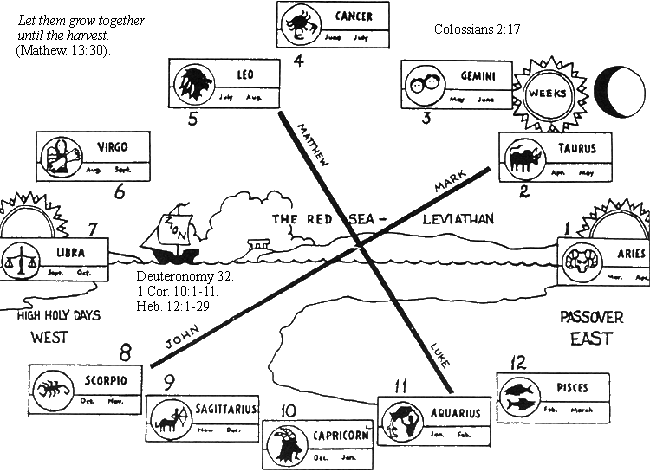
Ezekiel, chapters 1 and 2; Who is this Son of man?...John 12...(KJV).
Now open the first several chapters of the Book of Luke. (Recall that Luke was a disciple of Paul, and that Luke knew that there was a totally hidden element to the Gospel narratives, and that God has chosen to reveal His son in Paul...Galatians 1:15,16). Then see in Zacharias, the father of John the Baptist, an embodiment of the prophecies contained in the Book of Zechariah, all of which will be fulfilled in the last days. See in Elizabeth (El Sabat) the embodiment of all the mysteries contained in the idea of the number Seven. Understand why Jesus was conceived by a Virgin and born Six months after John (Luke 1:26-33). See in Joseph and Mary (Osiris and Isis) a connection between the Egyptian and Druid mysteries...
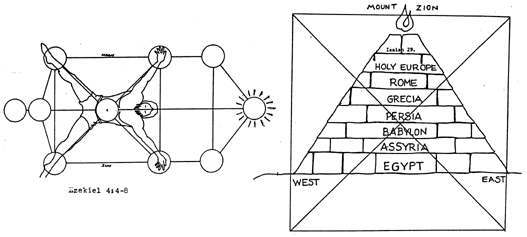
And their dead bodies shall lie in the street of the Great City (Jerusalem), which is spiritually called Sodom and Egypt, WHERE ALSO OUR LORD WAS CRUCIFIED...(Revelation 11:8).
See in Mary (Mare, the Sea) an embodiment of the Waters of Life, the amniotic fluids from which all of Life emerges, as well as the Great Sea through which the children of Israel have passed on their way to the fullness of time and the ends of the age. See in the words of the angel, at Luke1:15-17, and in the words of Zacharias at Luke 1:67-80, a foreshadowing of those things that are coming to fruition in our own time. See in the magnificat of Mary at Luke 1:46-55, a projection of Hannah's words at 1 Samuel 2:1-10. See in the figure of the just and righteous Simeon at Luke 2:25-35, a shadow of Simeon the Just, the Druid High Priest who officiated in that holiest of places at the Center of the Hebrew Mysteries, at the placed named Beauty on the Tree of Life. (Ecclesiasticus 50:1-23...KJV). And then see in Anna the prophetess (Luke 2:36-40), a figure not only of the ancient Hannah (or for that matter, a figure of the goddess Di-Anna), but another "feminine" embodiment of the European mysteries. The root word for the Hebrew-Gaelic name, Anna, which is AN, branches off to provide us with two separate terms that are essential to our understanding of the epic and allegorical narrative of the Gospels. The first is ANnual (or the great Solar-Lunar Year of the Hebrew Mysteries), and the second is ANus, or ASS. And therefore the wholly symbolic and allegorical word of Zechariah:
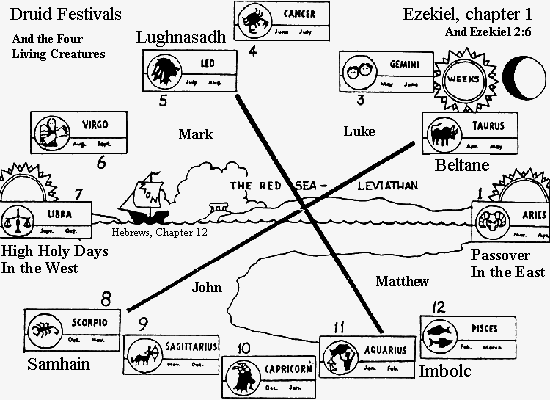
Rejoice greatly, O daughter of Zion; shout, O daughter of Jerusalem: behold they King cometh unto thee: he is just, and having salvation; lowly, and riding upon an ASS (the Great Solar-Lunar Year), and upon a colt the foal of an Ass...(Zechariah 9:9).